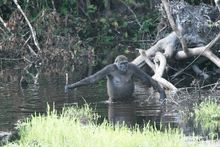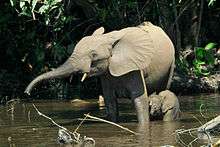Nouabalé-Ndoki National Park
Nouabalé-Ndoki National Park is in the Sangha and Likouala region of the Republic of the Congo. Together with the Dzanga Sangha National Reserve in the Central African Republic and Lobéké National Park in Cameroon they constitute the UNESCO World Heritage Site Sangha Trinational.

Understand
History
Nouabal-Ndoki National Park is a national park in the Republic of the Congo. Established in 1993, north of Congo, it is mostly populated with elephants, apes, ranging from Western Lowland Gorillas to chimpanzees and bongo. It is 3,921.61 km² (1,514.14 sq mi) of pristine tropical rainforest with no human habitation within it and with least habitation in the peripheral villages. The forests have a rich biodiversity of 300 bird species, plus 1,000 plant and tree species which include endangered mahoganies.
In a conference of the Ministers of Forests of Central African Forest Commission (COMIFAC), it had been resolved to establish within the Congo basin, the Sangha River Tri-national Protected area (STN) with a total area of 2,800,000 ha (6,918,951 acres) encompassing the Dzanga Sangha Special Reserve (the second largest area in the world) in the Central African Republic, which incorporates within its ambit the Nouabalé-Ndoki National Park in the Republic of Congo (Brazzaville) and the Lobéké National Park in Cameroon. The concept of creating reserved parks emerged in the 1980s with the realization that wild roaming elephants which moved freely in the entire region of the three parks needed to be protected from poachers and the logging industry.
The Nouabal-Ndoki National Park, managed by the WCS Congo jointly with the Ministry of Forestry, is one of the five protocols signed between them that specifies the responsibility of each partner of the protocol to ensure protection of the areas to defined international standards. Plans to establish the Nouabale-Ndoki National Park were initiated in 1991 by the Wildlife Conservation Society (WCS) and the Government of Congo with support from USAID as a transboundary collaborative project. It also involved a progression of interaction with local, regional and national authorities. It was finally established in September 1993 covering an area of 392,169 ha (969,070 acres) between the North-eastern Sangha Department and the north-western Likouala Department of Congo. In 1999, the timber company CIB (Congolaise Industrielle du Bois) and the local community joined hands with WCS and the Government of Congo to create an entity that would minimise the negative impacts of logging on the national park. In 2001, the park area was extended with part of a neighbouring logging concession known as the Gouloago triangle getting annexed to this park. The German logging firm surrendered its rights over 100 km² (39 sq mi) of the Goualougo Triangle under its lease hold to be merged with the national park, and also resolved to ban hunting. While logging operations (particularly of two species of the African Mahogony for high-grade timber) have taken place in many forest regions in the northern Congo to a limited scale, this park has been free of any such operations. This has resulted in the fact that it has been beneficial to effective preservation and growth of population of the wild life and natural habitat of the forests in the park.
Landscape

Flora and fauna
Climate
Get in
Fees and permits
Get around
See
Mbeli Bai is a specific area within the park where the gorillas reside and visitors visit regularly to see them.